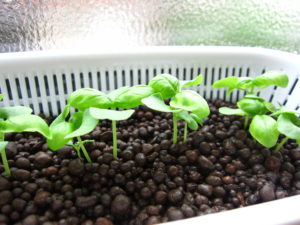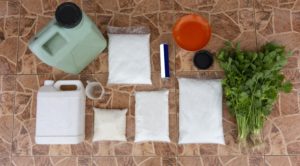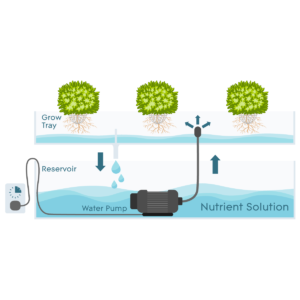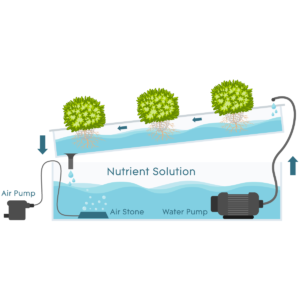Basics of DIY Nutrient Solution
If you want to mix your own hydroponic nutrient solution, then you’re in luck. We have all the guides you need to make your DIY nutrient solution. But first, it’s important to look at the basics of DIY nutrient solution so you know what you’re working with. Keep in mind that do it yourself nutrient solution isn’t for everyone- and if you’re just starting out, it might be a safer bet to get premixed formulas. That said, even if you’re a beginner, and understand the basics of how NPK ratios, macronutrients, and micronutrients work, you can do it.
What You Need to Make DIY Nutrient Solution
In your typical, premixed nutrient solutions, you can have one bottle, two bottles, or even three bottles to mix with water. If you want to make your own hydroponic nutrient solution, you’ll need more tools than just a measuring cup. You’ll need tools for mixing, tools for weighing and measuring, large buckets, and sometimes a few more things.
Let’s go over the basic tools, aside from nutrients, you need to make your own DIY nutrient solution:
- Mixing tools- whisk, large wooden spoon, paint mixer
- Containers – lidded buckets (preferably 10 gallons, or multiple 5 gallon buckets), mixing bowls
- Gloves, mask, eye protection (for working with certain elements)
- Standard measuring cups – from ¼ cup to 1 cup
- Measuring spoons – from ⅛ tsp to 1 tbsp
- Purified water – ideally by reverse osmosis
- Nutrients (we specify these in our recipes)
Things to Know Before Making DIY Nutrient Solution
Before you get going, there are some things you need to know. First, it takes some time to get the process down. Don’t worry if you struggle a little at first. However, you should make sure you know about what nutrients your plants need, how to test your nutrient solution, and how to correct pH or EC levels.
Plants need two categories of nutrients: macronutrients and micronutrients.
Macronutrients are those elements that plants consume large amounts of over their lifetime. Micronutrients are elements that plants still need, but in much smaller quantities. Even if they don’t need much, micronutrients are a critical component of nutrient solution that you absolutely can’t skip.
Because plants don’t need high amounts of micronutrients, you often end up diluting the initial mixture. Simply put, it’s difficult to measure out small enough quantities to make a micronutrient solution without overdoing it. Nutrient toxicity can still happen with micronutrients.
For example: you might mix a liter of water with micronutrients. Then, you might take a cup or half of a cup, and mix it with another liter or gallon of water.
Even if you order the smallest package of nutrients, chances are you won’t end up using much of them.
Mix Properly
Once you measure out all your nutrients, it’s tempting to pour them into a bucket of water, mix well, and call it good. However, that’s not the best way to do it. As we mentioned, even the first batch of micronutrient solution typically needs to be diluted. That isn’t often the case when you mix macronutrients (unless you make your solution too concentrated). That alone makes it a poor choice to mix macro and micronutrients at the same time.
Whether you’re mixing micronutrients or macronutrients, it’s best to mix your nutrient solution one element at a time. It may seem tedious, and it does take more time, but it’s worth taking the extra steps. It allows you to ensure that each element dissolves completely, and creates a uniform solution.
Always use clean tools to mix and measure any nutrients. It only takes a small thing to turn into a big problem for your plants. It’s a good idea to have extra containers or buckets for mixing, rather than risking having too few. If you test your EC and it’s too high, that means you’ll likely need another container to dilute it.
Safety First
It’s always best practice to use proper safety gear whenever you work with any kind of chemical or fertilizer. The same goes for when you make your own nutrient solution. It’s best to wear gloves, and even eye protection when you mix nutrients, especially if you’re not working with a closed container, like a bucket with a lid.
Some compounds even require wearing a mask to work with, so make sure you check the safety precautions before you begin.
Always be careful of mixing volatile compounds together. Never mix elements unless you’re sure of the reaction.
Use the Right Formula
Don’t choose a nutrient solution recipe at random. Plants have different needs throughout their lifespans, and these needs also vary depending on species. One thing to note is that young plants don’t need a lot of supplemental nutrients. We do have a recipe for nutrient solution for sprouts and young plants, but it’s diluted more than our other recipes. Even if you were to buy a premixed nutrient solution, you’d still need to dilute it to haf strength, or even less to give it to very young plants.
As plants emerge from the seedling stage, they begin entering the vegetative stage. This is where they put the majority of their energy and resources into growing more foliage (leaves and stems). They need a lot of energy and sugars to grow to their full potential. That also means they need much higher levels of nitrogen than any other element. Nitrogen is a key component of chlorophyll, where plants get their green color, and initiate photosynthesis. Ultimately the ability to photosynthesize allows them to convert more sunlight into usable energy such as carbohydrates.
Some plants remain vegetative, but many produce flowers, and eventually seeds, whether bare or in a casing, such as fruit. As plants enter their flowering and fruiting stage, they need less nitrogen, because they’re not focusing on vegetative growth as much. Instead, they need more phosphorus and potassium to reach their full potential.
If you give a flowering plant a vegetative nutrient formula, they might still produce flowers and fruit. However, they won’t produce as much as they otherwise could with the proper formula. Because they’re focusing so heavily on their reproductive phase, they also often suffer nutrient deficiencies without the right formula.
Top 5 Tips for DIY Nutrient Solution
You know the basics now, but there are a handful of tips that can help you get on the road to success. These five tips will help you make better nutrient solution, and grow bigger plants.
1. Don’t neglect other conditions
It can be easy to focus all your attention on creating the perfectly balanced nutrient solution. However, there are plenty of other issues that present symptoms that look a lot like nutrient deficiency. If you’re worried about your plants’ health, always check your pH and EC levels first. If those look good, check out other environmental factors. Plants can also get tip burn from excessive heat or light. Pests and infections can also create a wide range of symptoms that look like nutrient deficiency or toxicity. Don’t count on one thing as either a problem or solution.
2. Get the right scales
With some nutrients, you can measure by volume. You might be able to measure out a ½ cup of nitrogen and call it good. However, other nutrients need specific measurement, by weight rather than by volume. Use the most precise scales you can find. If possible, it’s best to use two scales. Use one that’s accurate to .01, for larger measurements. Then, use one that’s accurate to .001, for smaller, more precise measurements, like small doses of micronutrients. And always calibrate your scales on a regular basis to avoid poor measurements.
3. Know the different forms of elements
When you start looking into nutrients, you’ll see terms like phosphate, sulfate, chelated, non chelated, carbonate, and more. While these are all valid forms of different nutrients you can use, they don’t all work the same. The good news is you can often substitute one form for another, if your top choice isn’t available. At the end of this article, we’ll give you a reference chart you can use to tell them apart.
4. Store nutrients properly
Depending on the nutrient, you can expect a pretty fair shelf life. However, the shelf life depends a lot on how you store your nutrients. In general, it’s best practice to toss out nutrients once they’re over a year old. When you look at any nutrient’s shelf life, you’re typically looking at a ‘best case scenario’ type of situation. Keep your nutrients well sealed, in a dry, cool place. Never leave nutrients out around pets or children, and clean up well after you use them and measure them out. It’s far better to take a few extra minutes of precaution rather than risk a big accident.
5. Start with pure water
It’s worth investing in the purest possible water for your hydroponic system, especially if you’re mixing homemade nutrient solution. Even if you have great local tap water, there are still plenty of different chemicals and elements in it. Tap water always contains some amount of chlorine to clean the water, fluoride, and some amount of calcium and magnesium. Some growers recommend leaving tap water sitting out for a day or two to evaporate the chlorine in the water. However, this method makes it hard to completely get rid of all the chemicals. Even regular, purified water contains some additives, like electrolytes and salts for taste.
Related: Water quality in hydroponics
Don’t waste your effort by mixing a diy nutrient solution with water that already has other elements within it. The very best thing you can do is use reverse osmosis (RO) water when you make nutrient solution. RO water has the least amount of any other element or contaminant in it, and it ensures your nutrients stay as balanced as when you first measured and mixed them.
Try this R.O system:
Cheat Sheet: The Different Forms of Elements and Nutrients
One of the biggest reasons you need to understand different forms of nutrients is because it tells you what else your primary nutrient comes with. You’ll see things like calcium nitrate, magnesium sulfate, or ammonium phosphate. They’re still a great way to get nutrients, but you should understand how the different forms of these nutrients ultimately affect your solution.
Carbonate – Carbonates are compounds that consist of both carbon and oxygen. These can come from CO2, but they can also come from carbonic acid. The main difference is the ions in the compounds.
Chelates – Chelated minerals undergo a process wherein they’re bonded to certain amino acids. Metallic minerals in particular, tend to come in chelated form, especially when they’re used for fertilizers in agriculture.
Nitrate – This indicates the primary element is accompanied by salts that dissolve into nitrogen ions.
Phosphate – This tells you that there are phosphorus salts in the fertilizer, and there will be higher phosphorus when it’s dissolved in water.
Sulfate – This term lets you know that sulfur is a part of the mixture you’re using. Sulfur isn’t one of the top macronutrients, so make sure you don’t add more than necessary.



